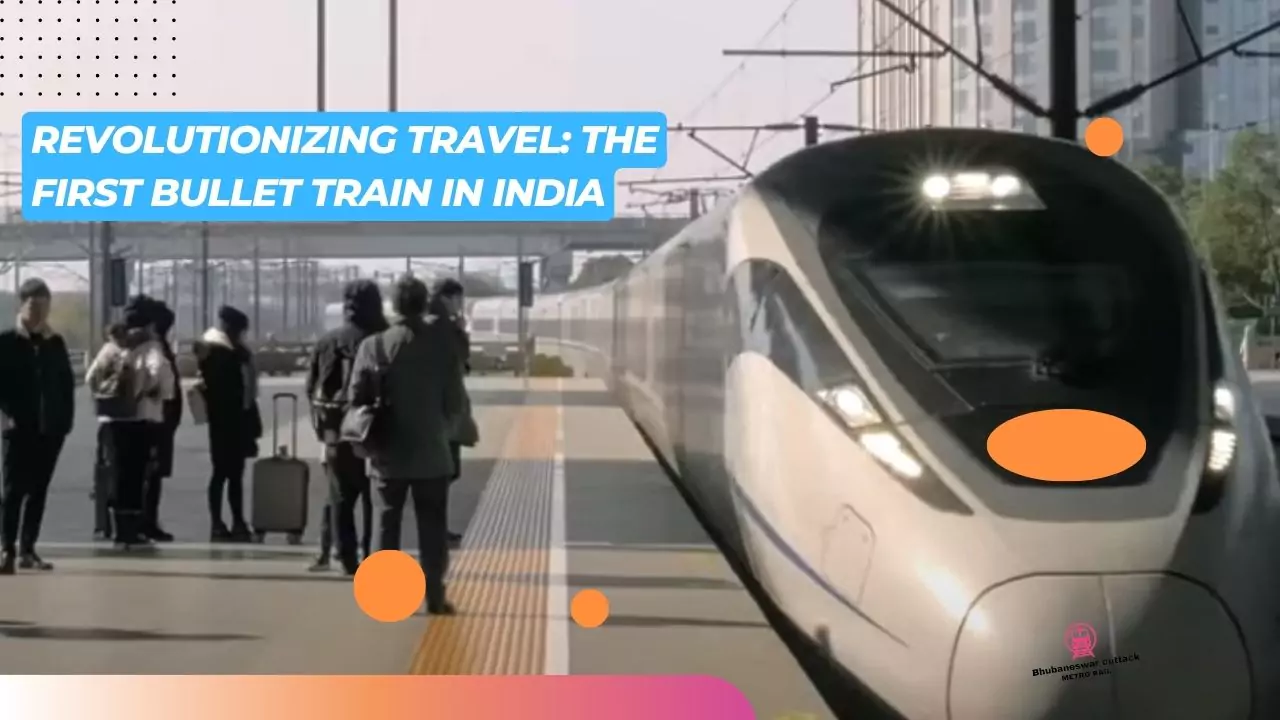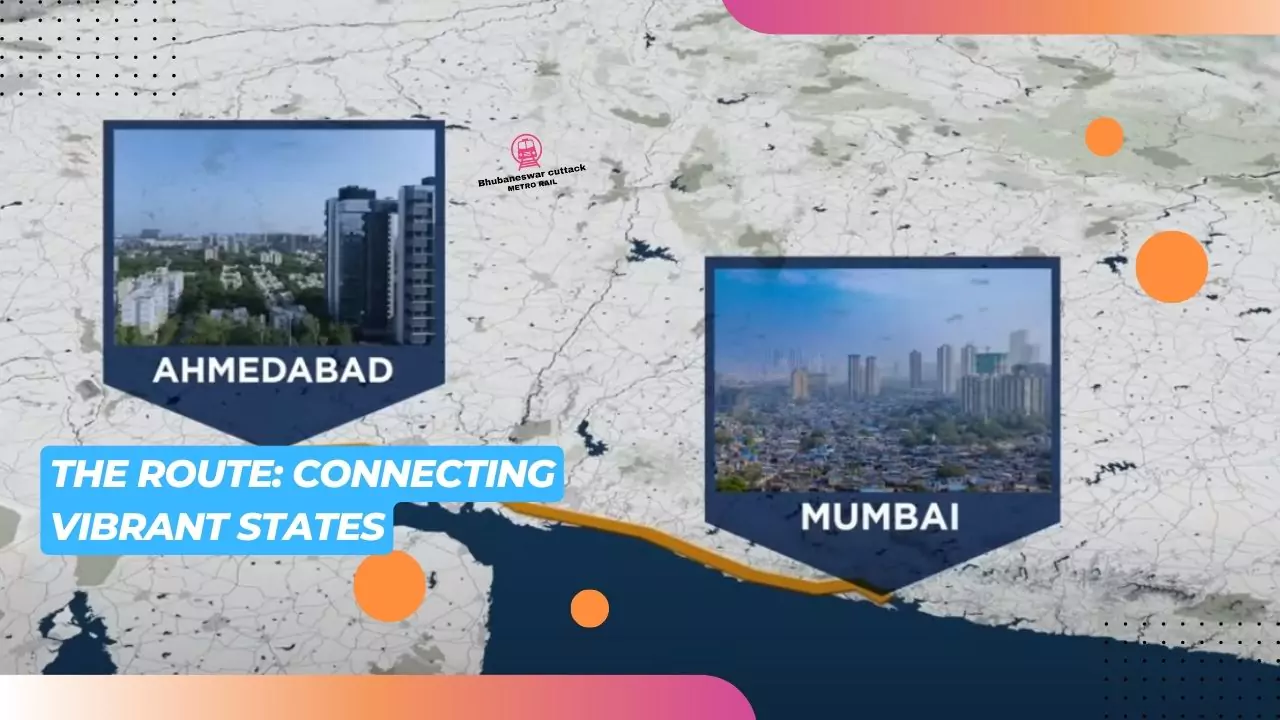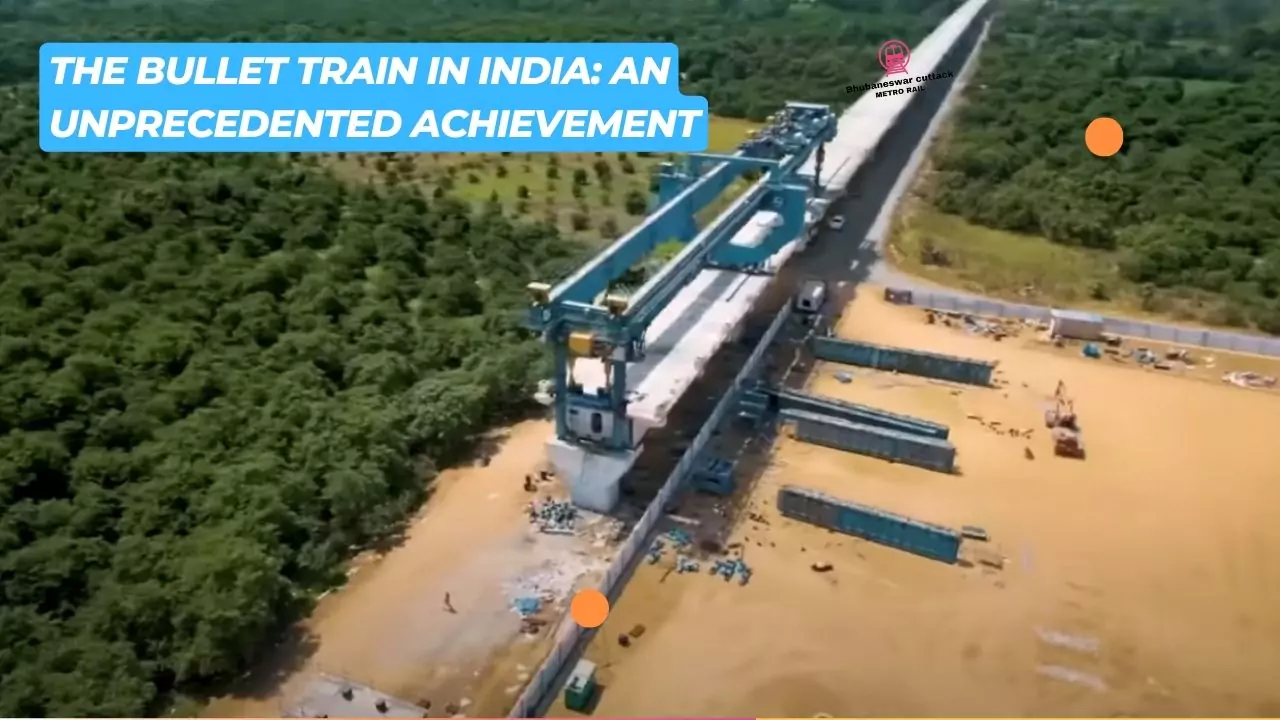Bullet Train in India Introduction.
India, known for its diverse culture and vibrant landscape, is now embracing a new era of rapid transportation with the introduction of the first bullet train! Breaking boundaries and pushing technological advancements, this project is set to revolutionize travel across the nation. In this article, we will explore the bullet train in India, its route, completion date, cost, advantages, and fare, taking a closer look at the transformative impact this new mode of transportation will have on India’s infrastructure.

You May Also Read Navigating Paradise: Lakshadweep Island Transport Unveiled!
The Bullet Train in India: An Unprecedented Achievement
India’s first bullet train project is a testament to the nation’s commitment to progress and development. With cutting-edge technology and a focus on efficiency, safety, and speed, the bullet train will transform the way Indians travel, opening new doors of opportunities economically, socially, and culturally.
How many bullet train in India? Is bullet train work started in India?
India has not yet fully operationalized its first bullet train. The Mumbai-Ahmedabad High-Speed Rail (MAHSR) project is the first bullet train project in India. The construction was ongoing, and the target completion date was in the future. For the most recent and accurate information on the number of operational bullet trains in India,
Does India need bullet train? Is bullet train a necessity in India?
The question of whether India needs a bullet train involves a complex evaluation of various factors, including economic, infrastructural, and social considerations. Here are some arguments for and against the introduction of bullet trains in India:
Arguments in favor of Bullet Train in India:
- Economic Growth: Proponents argue that high-speed rail can contribute to economic growth by improving connectivity between major cities, facilitating faster movement of goods and people, and potentially boosting industries along the route.
- Technological Advancement: Introducing bullet trains showcases technological advancement and can position India as a country embracing modern transportation solutions.
- Reduced Travel Time: High-speed trains significantly reduce travel time between cities, making long-distance travel more efficient and convenient.
- Environmental Benefits: While the initial construction may have environmental impacts, the operational phase of high-speed trains can be more energy-efficient and environmentally friendly compared to other modes of transportation.
Arguments against of Bullet Train in India:
- Cost Considerations: Critics argue that the cost of implementing a high-speed rail network is extremely high, and the resources invested could be utilized for other pressing needs such as improving existing railway infrastructure, healthcare, and education.
- Existing Railway Issues: Some believe that addressing the existing issues in the conventional railway system, such as safety, punctuality, and accessibility, should take precedence over introducing a high-speed rail network.
- Affordability and Accessibility: The cost of tickets for high-speed trains may be relatively high, raising concerns about affordability for a significant portion of the population. Additionally, the coverage of the high-speed rail network may be limited, leaving many areas without direct benefits.
- Alternative Modes of Transport: Critics argue that India already has a well-established railway network and other modes of transport, and the focus should be on improving the efficiency and safety of these existing systems.
In summary, the need for a bullet train in India depends on the priorities and perspectives of policymakers and the public. It involves striking a balance between the potential economic benefits, technological advancements, and addressing the existing challenges and needs of the country. Public opinion, economic feasibility studies, and ongoing developments should be considered when assessing whether India should invest in a high-speed rail network.

The Route: Connecting Vibrant States
The bullet train’s ambitious route will connect two major cities, Mumbai, the financial capital of India, and Ahmedabad, the bustling city in Gujarat. Covering a distance of approximately 508 kilometers, this high-speed rail corridor will pass through the states of Maharashtra and Gujarat, enabling swift and convenient travel for both business and leisure purposes.
The Completion Date: A Glimpse into the Future
Anticipation runs high as India prepares for the grand unveiling of its first bullet train. The project, which began with a groundbreaking ceremony back in 2020, is expected to be completed by the end of 2025. The construction work is progressing steadily, and with each passing day, the dream of experiencing the thrill of high-speed travel draws closer.

The Cost of Bullet Train in India Project: An Investment in India’s Future
Building a state-of-the-art transportation system comes with a significant investment, and the bullet train project is no exception. With an estimated cost of around $17 billion, including the price of infrastructure, technology, and human resources, this project highlights India’s unwavering commitment to progress. Though the price tag may seem substantial, the long-term benefits and the boost to the economy are expected to far outweigh the initial expenditure.
Advantages of the Bullet Train: Unparalleled Benefits
The introduction of the bullet train in India brings forth a myriad of advantages, highlighting the significant impact it will have on India’s transportation landscape.
What is the speed of bullet train in India? Lightning-fast Speed: Saving Time, Expanding Possibilities.
The bullet train’s top speed of 320 km/h ensures an efficient and time-saving journey for passengers. Cutting down travel time between Mumbai and Ahmedabad from 7-8 hours to a mere 2-3 hours, this high-speed rail will provide a viable alternative to air travel, reducing congestion and delays while allowing travelers to arrive at their destinations promptly.
Enhanced Comfort: A Luxurious Experience
Equipped with state-of-the-art amenities, plush seating, and modern facilities, the bullet train promises a luxurious travel experience for its passengers. With spacious interiors, offering ample legroom and ergonomic seating, the journey will be a comfortable one, ensuring passengers arrive at their destinations relaxed and refreshed.
Eco-friendly Travel: A Greener Future
The bullet train’s eco-friendly design offers a sustainable mode of transportation, significantly reducing carbon emissions when compared to other modes of travel. By promoting the use of high-speed rail, India takes a proactive step towards combating climate change and protecting the environment while meeting the demands of a growing population.
Economic Growth: A Catalyst for Development
The Bullet Train in India project is poised to bring about economic growth, development, and job creation, both during its implementation phase and afterwards. The construction of the rail system will generate numerous employment opportunities, while increased accessibility between Mumbai and Ahmedabad will foster trade, tourism, and cultural exchange, benefiting both cities and the regions they represent.
Bullet Train in India Fare: Affordable Travel for All
One of the key concerns for any mode of transportation is its affordability. The bullet train aims to strike a balance, ensuring a comfortable journey without exorbitant fares.
- The exact fare structure is yet to be announced, but it is expected to be competitive compared to other modes of transportation, such as air travel.
- The fare will likely be tiered, offering options suited to various budgets.
- Special concessions and discounts for students, senior citizens, and frequent travelers are anticipated, making the bullet train accessible to a wide range of passengers.
Bullet Train in India FAQs
Q: Will the Bullet Train in India project cause displacement of communities along the route?
A: The bullet train project is committed to minimizing the displacement of communities. Extensive studies and consultations have been conducted to ensure designated land acquisition and resettlement measures minimize any adverse impacts.
Q: Will the bullet train replace other modes of transportation entirely?
A: While the bullet train will provide a popular alternative for travel between Mumbai and Ahmedabad, other modes of transportation, such as air travel and conventional trains, will continue to serve different routes and cater to various needs.
Q: How will the bullet train contribute to the development of local industries and businesses?
A: The bullet train project is expected to have a positive ripple effect on local industries and businesses. Improved connectivity will enhance trade and tourism between Mumbai and Ahmedabad, boosting local economies and creating new opportunities for businesses to flourish.
What is the Bullet Train project in India?
The Bullet Train project in India refers to the Mumbai-Ahmedabad High-Speed Rail (MAHSR) project, which aims to introduce the country’s first high-speed rail network connecting Mumbai and Ahmedabad.
When was the Bullet Train project initiated in India?
The project was initiated in September 2017 when Prime Ministers Shinzo Abe and Narendra Modi laid the foundation stone for the Mumbai-Ahmedabad High-Speed Rail project.
What is the proposed route of the Bullet Train in India?
The Bullet Train will connect Mumbai and Ahmedabad, covering approximately 508 kilometers. The route includes key stations like Surat and Vadodara, enhancing connectivity between major cities.
When is the expected completion date of the Bullet Train project?
While the project was initially targeted to be completed by 2023, construction timelines can be subject to change. For the latest updates on the completion date, it’s advisable to refer to official announcements from relevant authorities.
What are the key features of the Bullet Train in India?
The Bullet Train will operate at high speeds, significantly reducing travel time between Mumbai and Ahmedabad. It will feature state-of-the-art technology, ensuring a comfortable and efficient travel experience.
How much will the Bullet Train in India project cost?
The estimated cost of the Mumbai-Ahmedabad High-Speed Rail project is substantial. For detailed information on the project’s cost breakdown, it is recommended to refer to official reports and announcements from the concerned authorities.
What are the advantages of the Bullet Train in India?
The Bullet Train is expected to bring several advantages, including reduced travel time, enhanced connectivity, potential economic growth along the route, and a shift towards more sustainable transportation.
Will the Bullet Train be affordable for the general public?
The fare structure for the Bullet Train is yet to be finalized. However, considerations for affordability and accessibility are likely to be taken into account during the planning process.
How will the Bullet Train impact the environment?
While the construction phase may have environmental implications, the operational phase of high-speed trains is generally considered more energy-efficient and environmentally friendly compared to certain other modes of transportation.
Conclusion
India’s first bullet train project marks a significant milestone in the nation’s development and progress. The high-speed rail system will revolutionize travel, connecting major cities and promoting economic growth while offering a comfortable, efficient, and eco-friendly mode of transportation. With completion slated for 2025, the countdown ensues, and Indians eagerly await the day they can marvel at the wonders of the first bullet train in India!

